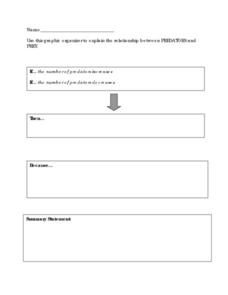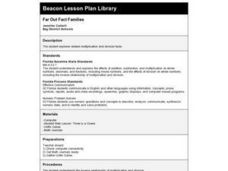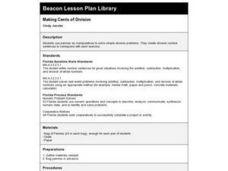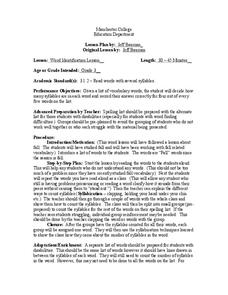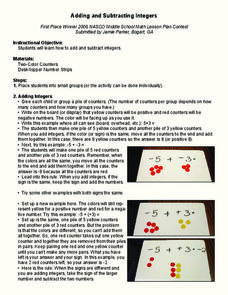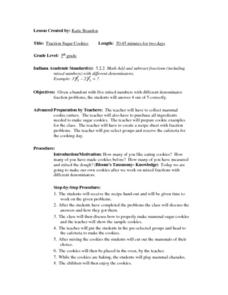Scholastic
Eric Carle Author Study
Learn all about Eric Carle, find out about his famous caterpillar, and try out related art, science, writing, math, and social studies activities. The resource comes with plenty of materials to support your instruction.
Vita Education Services
Past Continuous Game
Your pupils were studying the past continuous when you realized that they could benefit from this game! Learners roll a die and complete the sentence they land on. They will have a chance to begin and end sentences.
Balanced Assessment
Fractured Subtraction
Can you spare a 10? Scholars determine digits that could complete a two-digit subtraction problem. They must find all possible combinations of digits and provide an explanation for their reasoning.
Balanced Assessment
The Contest
Good advertisers can make mathematics seem irrelevant. Teach your classes to use math to see through these tactics and make good decisions. The posed task has pupils analyze sweepstakes statistics to determine and compare the cost of...
Charleston School District
Review Unit 1: Exponents
What will be on the test? The resource provides comprehensive review items for the content of the unit on exponents. The resource divides the sections in the order you present the lessons during the unit.
Humanities Texas
Primary Source Worksheet: Abraham Lincoln, Letter to Horace Greeley
Through close analysis of a primary source document and discussion questions, learners gain great insight into how Abraham Lincoln viewed his duties as president of the United States, as well as his response to those who criticized...
Curated OER
Predators and Prey
Students explain how the food chain works. They contrast predators with prey and describe their function in nature. Students discuss how the food chain aids in keeping nature balanced. In small groups, they play a game that simulates the...
Curated OER
Far Out Fact Families
Second graders explore related multiplication and division facts. They study the inverse relationship of multiplication and division and engage in a group discussion about families. They complete a web-based lesson which is imbedded in...
Curated OER
Making Cents of Division
Third graders use pennies as manipulatives to solve simple division problems. They create division number sentences to correspond with each exercise. This is a good, hands-on way to teach the concept of division.
Curated OER
Permutations and Combinations
In this Probability worksheet, learners solve problems involving permutations and combinations. The one page worksheet contains 10 questions. Answers are not included.
Curated OER
Team Up
Young scholars discover how to break into equal teams. In this dividing lesson plan, students break different numbers of people into equal groups. Young scholars draw pictures to represent their division and discuss what to do when an...
Curated OER
Word Identification Lesson
Third graders listen to a list of Fall words and then repeat them aloud as a class. They discover how to count syllables either by holding their hand under their chin or clapping and practice together as a class and then split into small...
Curated OER
The Nest Striking Activity
Students demonstrate striking skills and multiplication facts. In this striking skills lesson, students use multi-colored hoops to practice their striking accuracy. Students track their accuracy in various ways, such as the total number...
Curated OER
Find a Pattern
In this patterns worksheet, 4th graders determine which patterns to use to solve 8 problems involving 2 math scenarios and then find the next 3 numbers in 2 groups of numbers.
Curated OER
Math Investigations
Students demonstrate how math is used in everyday life. In this math investigation activity, students develop a class-list of ways they use math everyday. Students define math vocabulary words, such as "counting," "daily life," and...
Curated OER
Combination Vs. Permutation
In this probability activity, students analyze word problems, determine whether the situation is a combination or a permutation, and solve. There are 5 multiple choice questions.
Curated OER
Toboggan Science
Young scholars conduct toboggan time trials to investigate the variables that have the greatest effect on toboggan speed. In small groups, they develop a hypothesis to test and perform three trials on the toboggan run for each variable.
Curated OER
Not So Snappy 12- Word Problems
In this division word problem worksheet, students solve 5 problems. They work with the divisor, dividend, quotient, and in some of the problems, a remainder as they use the information from each word problem.
Curated OER
Adding and Subtracting Integers
Students explore how to add and subtract integers. In this integer lesson students are broken into groups and participate in an activity that helps them investigate how to add and subtract integers.
Curated OER
Investigation - The Bakery Shop
Learners participate in mathematical music and subtraction using their fingers when indicated in the song. In this music/math lesson, students count their fingers and pretend their fingers are cookies. Learners sing the song and...
Curated OER
Fraction Sugar Cookies
Fifth graders practice addition, subtraction,and conversion of fractions by making cookies from a recipe. Students convert mixed number into compound fractions and combine fractions using addition in order to make a certain amount of...
Curated OER
Introduction to Fractions
Fourth graders break into groups having 10 come to the front and figure out the fraction of students are wearing jeans, glasses, have brown hair, etc. They write the fraction together. Each student then makes a picture and be able to...
Curated OER
Learning Numbers
Students are introduced to their numbers and practice counting by ones, fives and tens. In groups, they match numbers and words and discover what numbers come before and after a given number. They also practice writing numbers and words.
Curated OER
Egyptian Society
Students make body cut-outs out of butcher paper dressed to represent seven different economical statuses of Egyptian society. Students then write papers about their assigned socioeconomic status.






